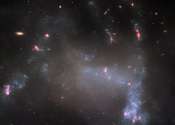A triumph of galaxies in three new images from the VLT Survey Telescope
Distant galaxies, interacting galaxies, whose shape has been forged by the mutual gravitational influence, but also galaxies forming groups and clusters, kept together by gravity—they are the protagonists of three new images ...









